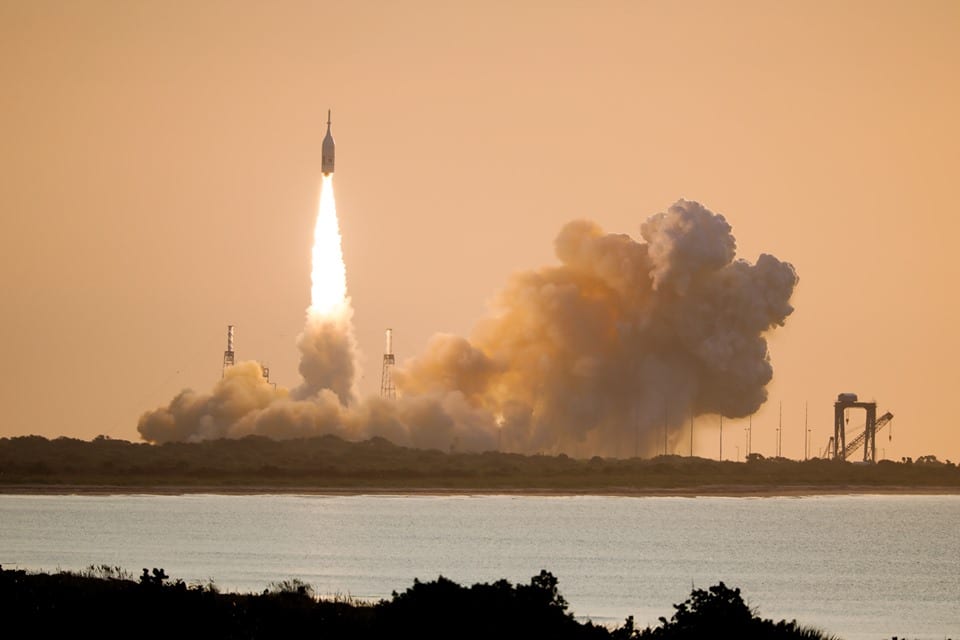The Launch Abort System’s Success Follow-up: Coming Next, the Lunar Getaway!
July 3rd, 2019
by Andrea Lloyd

Have you watched it? A successful launch, that what it was!
NASA demonstrated the Orion spacecraft’s launch abort system’s (LAS) capabilities to outrun a speeding rocket and return the astronauts safely to the Earth’s surface in the case of an emergency.
If all goes well, this will be the only time we will ever see the test. If you’re looking for a breakdown of what the Ascent Abort 2 flight test (AA-2) is and how it works, read last week’s article about everything you need to know about the AA-2 test.
The Launch Abort System: How Did Things Go Down?
During the three minute AA-2, a test version of the Orion crew module launched yesterday at 7 a.m. ET from Space Launch Complex 46 at Cape Canaveral Air Force Station in Florida.
- The rocket traveled about 6 miles high, at which the abort sequence was triggered. Within milliseconds of reaching the altitude, the abort motor fired, pulling the crew away from the modified Peacekeeper missile boost stage that brought it in the air in the first place.
- Next came the attitude control motors, orienting the crew so if the parachutes were deployed, they would catch maximum drag. (The Orion parachutes have been fully qualified for launch from the previous testing, and the boilerplate didn’t need recovery.)
- Then, the jettison motor shot the Launch Abort System away from the crew module
- Lastly, the time came for all three components: the Peacekeeper, the Orion capsule, and the Launch Abort System.

From there, a team collected the 12 data recorders that were ejected to be analyzed.
The Importance of the Launch Abort System and the AA-2 Test
“Launching into space is one of the most difficult and dangerous parts of going to the Moon,” said Mark Kirasich, Orion program manager at Johnson Space Center in Houston, Texas. “This test mimicked some of the most challenging conditions Orion will ever face should an emergency develop during the ascent phase of flight. Today, the team demonstrated our abort capabilities under these demanding conditions and put us one huge step closer to the first Artemis flight carrying people to the Moon.”
Return to the Moon
AA-2 is a crucial component to NASA’s new trajectory to return to the Moon by the year 2024, accelerating humanity’s return to the lunar surface. “History has proven when we’re given a task by the president, along with the resources and the tools, we can deliver,” said NASA Administrator Jim Bridenstine.
NASA has been directed that this return to the Moon, the Artemis missions, isn’t about planting a flag in the regolith, but about creating a lasting presence, a base, on the South Pole. An additional goal is to focus on public-private partnerships with American companies, which will both stimulate the economy and expedite the astronaut’s return.

The International Space Station (ISS) commenced in 1998, twenty years ago. If the science that we’ve discovered in microgravity, within those two decades, has significantly benefited the world we live in – academically, economically, and politically – shouldn’t we continue nourishing humankind’s desires to find their place in our universe? Shouldn’t the next big step be to return to the Moon?
The Lunar Gateway
As a part of Artemis, NASA plans to make a Lunar Gateway with the help of international partners to create an exploration and science outpost that orbits our neighboring sphere. It’ll be much smaller than the ISS, but focusing as a shuttle to the surface, like an airport.
The space agency anticipates the Gateway to be completed in five or six launches rather than the thirty-four that accomplished the space station.
The decreased number of launches is to help practice. How else will we make it to the red planet to revive our favorite Mars rovers? The moon will be used as a proving ground, practicing for in-depth space exploration.
The moon is only 238,855 miles from Earth, on average, while Mars is at minimum 33.9 million miles away when the planets line up just right with their orbits around the Sun. The moon is almost 142 times closer to Earth on Mars’ best day.
It’s much easier to build a new home close to home, all things considered.

What else would you like to know about the Launch Abort System and NASA’s plans to return to the Moon?
Photos courtesy of Lockheed Martin
Want more science now?
Check out our news page where we post interesting studies and discussions (sometimes mocking them mercilessly) for more.
